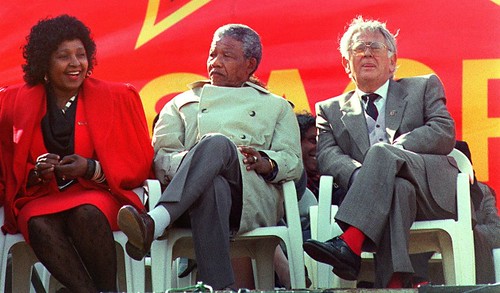
Winnie Mandela with Nelson Mandela and Joe Slovo at a rally of the South African Communist Party in 1990. Mandela was a member of the Central Executive Committee of the SACP., a photo by Pan-African News Wire File Photos on Flickr.
LALKARONLINE
Apartheid
After its election victory in 1948, the National Party (some of whose leaders had been locked up as Nazi sympathisers during the Second World War), guided by the racist ideology of apartheid, built a state to entrench white supremacy. Through more than 40 pieces of legislation enacted by the whites-only Parliament, the majority of the country's population were disenfranchised, forcibly evicted from their homes and from fertile land that they and their ancestors had cultivated for generations, and dumped in poor, bleak, rural surroundings or in townships to serve as a source of cheap labour.
Apartheid began at birth, with each child registered on the basis of his or her race. Inter-racial marriage and sex were outlawed under the Prohibition of Mixed Marriages Act and the grotesquely named Immorality Act. All areas were delineated according to race: white, black, Indian, or 'coloured'. Since the whites still needed non-white labour, blacks were legally obliged to carry a pass book, an identity document that stated if they had "section 10" entitlement, which permitted them to be in specific white areas for work, to do menial jobs as cooks, housemaids and gardeners and who inhabited a single room or a shed in the garden. They were liable to be stopped by a policeman at any time and to be asked, often in intimidating and abusive language, to produce their pass book.
The police, by and large white Afrikaner and racist to the core, were unhindered by any law and believed that the maximum use of force was the only way to deal with black people.
Any black person found in a white area without a permit was liable to immediate arrest and a fine or imprisonment, thereafter to be sent to a Bantustan, or 'homeland', even though he may have had no connection with the place. These homelands were dumping grounds for unwanted blacks. Side by side, needing black labour, every white town, no matter how small, would have a township.
Right to the present, the whole of South Africa represents a glaring contrast between the black rows of small brick shacks in arid streets of townships, on the one hand, and on the other opulent suburbs with palatial mansions, manicured gardens and swimming pools behind high walls in gated clusters, whose residents can enjoy their parasitic existence undisturbed by the sight of the millions on whose exploitation, destitution and misery rest their wealth and comfort.
Every aspect of life, from employment to public entertainment and public amenities, from the theatre to the toilet and the use of beaches, were covered by apartheid. Black children in schools were given truly inferior education and merely taught the subjects that prepared them for labouring jobs; and they were taught in Afrikaans, which led to the mighty uprisings of school children in 1976, jolting the regime out of its arrogant and smug complacency.
Under the Separate Amenities Act, world-class libraries, theatres, sports facilities and public toilets were made available for the whites and token low-grade facilities provided for blacks.
The black majority were subjected by the apartheid regime to brutal exploitation, with tens of thousands tortured, raped, forcibly sterilised. Thousands, including children, were murdered by the security forces. Several thousand innocent people were slaughtered by the South African armed forces in neighbouring countries. 14 million black people were brutally evicted from their land.
Under the 1950 Suppression of Communism Act, all criticism of apartheid, being perceived as communist, was prohibited, a crime which could attract imprisonment.
Mandela recalled his utter shock at being treated by white people as an equal at parties given by the Communist Party, which had recruited black members and undertook the only meaningful resistance to apartheid. Is it any wonder, then, that he should have joined it and come down in favour of armed struggle as the only weapon to overthrow the brutal apartheid regime?
After all, the South African Communist Party, from the 1920s and 1930s, under the direct influence of the Comintern, adopted the correct policy of working for an "independent native South African Republic as a stage towards a workers' and peasants' republic with full, equal rights for all races".
No comments:
Post a Comment